5 Best Survival Tent
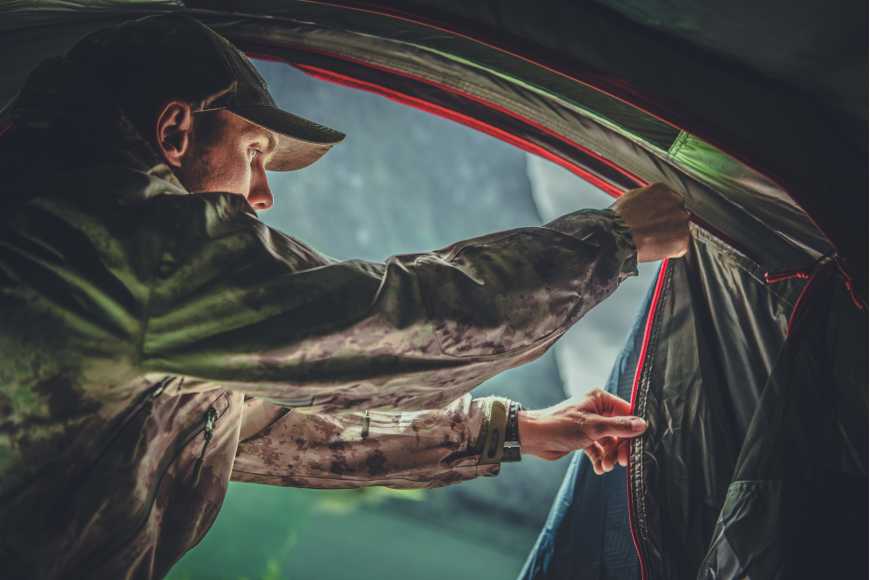
One of our basic human needs is shelter. If you're hiking or doing backcountry adventures, having a quality tent is more than a luxury.
It’s a necessity.
But there are different components to shelter: staying dry and warm; having enough room for your needs; being able to easily transport.
So we’re here to help you choose the best survival tent for your needs.
Choosing A Survival Tent
If you’ve decided you need a survival tent or emergency tent, there are a number of components to consider in your selection. The basic factors in choosing a shelter is that it will keep you warm, dry and safe from the elements.
But there are other elements.
For instance, are you buying a basic shelter that you want to add to an emergency kit? If so, you likely want a shelter “tube” that folds up into a small package.
If you’re backpacking regularly, maybe you want a more functional tent.
If you live somewhere that’s usually warm and humid, you may not want to choose a heavily insulated shelter that will be hot.
Here are 6 things for you to consider when choosing your survival tent:
Size And Number Of Occupants
If you’re on your own, your choice of a tent is much different than if you’re traveling as a family. The amount of gear you’re bringing along can be a factor as well.
If you’re doing a true “survival” weekend, you may be traveling alone and with minimal gear. If you’re looking for a simple emergency cover, your size choice will be different than something you use on a regular basis.
Even if you’re alone, you may have preferences for how much room you like inside your tent, including room for your gear.
Weight
Similar to size, the weight of your tent is a factor. If you’re packing it into an emergency kit and may not use it often, small and light is best. Similarly if you’re hiking.
If you are only carrying the tent short distances, you can opt for a slightly heavier one. However, for any type of backwoods adventure, weight is usually an important factor. Lighter is almost always better.
Fabric And Durability
Depending on the use of your tent, the fabric it’s made of and the durability of that fabric is important. Among our reviews are tents that are reflective to maximize warmth. Other tents are mesh with a weather-proof fly.
Once again, it depends how you’ll be using the tent. If you need to be warm and dry and that’s it, one of the tube-style reflective tents will be best. If you want the flexibility of mesh sides with the option to “batten down the hatches,” a more traditional tent will be a better choice.
Difficulty Setting Up
In an emergency, or in inclement weather, you’ll want a shelter that sets up quickly and easily. If you opt for a larger, more “tent-styled” shelter, you have to be prepared to take more time to set it up.
However, in any style of shelter, you likely want something that easy enough for one person to set up and take down in a short amount of time.
In a survival situation, speed is vital.
Color And Shape
While the color may not seem important, it actually is. For instance, visibility may be important to you in a true survival situation. Or if you backpack alone in extreme conditions, you may need to be rescued at some point. In that case, a bright color will be your best choice.
If you’re trying to stay hidden, you may want a camouflaged color.
Shape can be an important factor if you’re consistently in situations where it’s windy, for instance, or you’re setting up on the side of a mountain. An aerodynamic shape or a tent that sits low may be your best option.
Accessories
If you’re using your tent in survival situations, you need to stay dry and warm. So if it’s mesh, it has to have a rain fly that keeps you dry. That’s non-negotiable.
You may also like bonus features like a storage vestibule for gear and shoes. You can leave any wet gear outside, and know that it will be protected from the elements to dry. If it isn’t wet, it won’t get wet!
Features like a vestibule also gives you more space inside the tent.
Keeping those factors in mind, let’s take a look at five different options, to help you determine the best survival tent for your needs.
SharpSurvival Emergency Survival Shelter 2-Person Tent
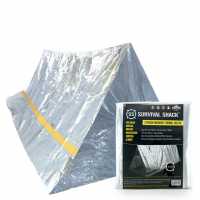
This is the ideal tent for emergency preparation, but also great for fishing, hunting, backpacking, climbing, hiking and more.
Perhaps its best feature is the speed of setup. In an emergency, or if weather turns bad, you simply separate the rope and shelter, and unfold the shelter and lay it flat on the ground. Then open the shelter, run the rope through both ends and tie it to something sturdy, like a tree. You can also widen the tent by spreading it along the rope.
Made of a mylar thermal material that is apparently used by NASA, it reflects 90 percent of body heat. It’s also waterproof and windproof.
Added to that, it’s reusable and extremely easy to pack. Put it in your emergency supplies kit or tuck it in your backpack.
Pros
- It’s compact and lightweight for transporting.
- It sets up in minutes.
- It’s 8x5 feet so has room for two people.
Cons
- It doesn’t close up. You’ll have to clamp the end shut or consider covering the ends with tarps if you want the ends closed.
- It’s noisy in the wind.
Our Take
SE Emergency Tube Tent

This option has a bit more to it than a simple shelter, with one closed end and one open end. The open end ties shut to provide a bit of a door, but you’ll probably have to clamp it if you want a tightly closed door.
It’s made with an aluminum-coated interior that insulates and reflects body heat, providing additional warmth. It’s also a bright orange so you’ll be seen easily.
It sleeps 2 with a measurement of almost 7 feet long by 3 feet wide and just under 3 feet high.
It’s waterproof, tear-resistant and re-usable.
Pros
- It includes 23 feet of rope and 4 tent pegs for easy setup.
- It has metal grommets to protect the fabric from the rope.
- It can also just be used as a blanket or ground cover.
Cons
- It needs to be clamped it to keep it tight at the top.
- You’ll likely need a tree to set it up.
Our Take
12 Survivors Shire 2-Person Tent
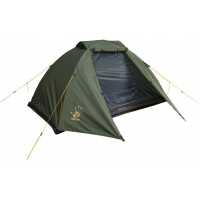
It’s sized to sleep two people, with a base size of about 7×3.5 feet, and a height of 3.5 feet.
It has two full-sized doors on each side, allowing for exit by either person. The exterior is mesh to allow for airflow. But there’s also a rainfly that easily buckles to each bottom corner. When the rain fly is set up, it extends over the doors to create two small “vestibules”. These allow you to have a bit more coverage outside the tent, where you can keep gear if necessary.
It’s small and lightweight, at about 5.5 pounds, to allow you to hike with it. It rolls up into its nylon carry bag that can attach on the bottom of a backpack.
Pros
- Easy to set up. Insert the aluminum pole ends into each corner grommet, and snap the clips onto the poles.
- It’s wide enough to fit an inflatable sleeping pad.
- The rain fly doors can be turned into awnings with the use of trekking poles - although those poles aren’t included.
Cons
- It’s a three-season tent, so if you need warmth, this isn’t it.
- It’s bigger to carry than some of the smaller tube-style tents.
Our Take
ALPS Mountaineering Extreme 2-Person Tent
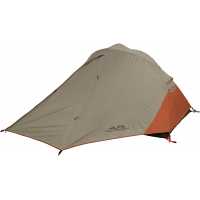
Another tent – as opposed to just a shelter tube – that’s a little bit bigger. Its base is just over 5 feet by almost 8 feet, with a center height of 3.5 feet. Its total weight is over 7 pounds.
This tent sleeps 2 and is easy to set up. It has a free-standing, three-pole design. It also has a rain fly that creates two vestibules for extra storage. The fly protects against rain and UV rays.
There are mesh windows and two doors, as well as storage pockets.
Pros
- The vestibules serve as automatic attachment points to provide a stronger base when the weather gets nasty.
- Comes with the poles, rain fly, stakes and bags for the stakes and poles, along with the guy rope and tent bag, but also includes some repair swatches.
Cons
- Does the fact it includes repair swatches mean it needs to be repaired often?
- It’s a little bit heavier if you are hiking or backpacking.
- Has a matching “floor saver” tarp but you have to buy it separately.
Our Take
Kelty TN 2-Person Tent
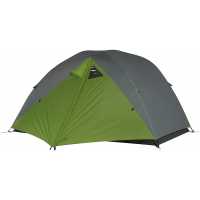
This tent has won a couple of awards as a backpacking tent from outdoor magazines.
At only 4 pounds, 9 ounces, it’s a superior tent at a very light weight. It’s also easy to pack up with shorter, 14-inch aluminum poles. It has a color-coded clip system that makes setup easy.
They call the fly a “Stargazing Fly.” That’s because it can be taken off completely, cover the tent completely, or be rolled back to cover only half the tent. In fact, with it rolled back to allow for stargazing, you can reach out the door and roll the cover closed without even leaving the tent.
It’s a three-season tent that sleeps two with a size of about 6×4 feet, and with the fly there are storage vestibules that add another 2 feet to each side. There are also 2 doors.
Pros
- The innovative fly that allows for three different setups.
- The fly can be staked up like a “porch” using trekking poles - which aren’t included.
- The lightweight makes it easy to transport.
Cons
- It’s a three-season tent, so if you need it in the winter, it’s not for you.
Our Take
While these are all considered survival tents, there are variations in the styles. Some are true shelters – useful for sleeping in and in emergencies. Others are intended for more use. Our top choice is the Kelty TN 2-Person Tent.
Here’s why we liked it better than the others:
- It’s big enough to sleep two people, but light at just under 5 pounds. That means it’s easy to pack up and take hiking, even in extreme conditions.
- It’s easy to set up and take down.
- The innovative three-position fly is a bonus. You can stargaze or get full light in the tent with it half open, and then close it without even leaving the tent if the weather turns bad.
- The storage vestibules are handy for extra storage and providing more room in the tent.
- Therefore, this tent addresses all the needs of a survival tent, with some bonuses. For three seasons, it has a decent size, it’s easy to set up, and it has some nice bonuses with the fly design and the vestibules.
If you’ve decided you need a survival tent, the Kelty TN is a great choice.
 Carla Arbuckle
Carla Arbuckle











